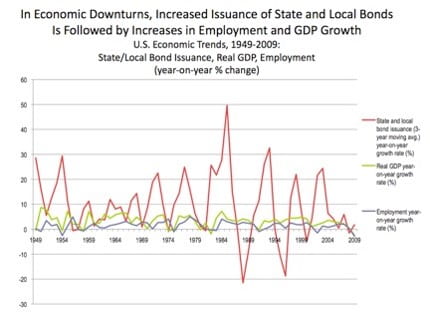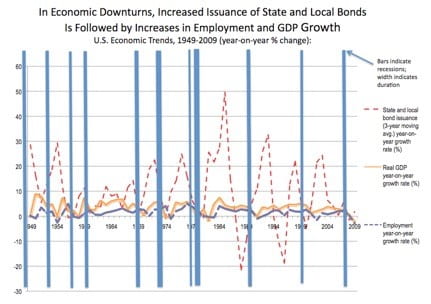Part IX of James Spiotto’s Fiscal Distress Myths and Realities focuses on solving fiscal distress through economic development and infrastructure
Myth: There is Little or Nothing Financially Distressed States and Local Governments Can Do to Improve or Turn Around Their Troubled Financial Situation Including as to Unfunded Pension Obligations
Reality: State and Local Governments Can Balance Their Budgets (Reducing Expenditures to that Which is Sustainable and Affordable), Invest in Needed Infrastructure Improvements and Stimulate Business Development and Expansion for their Community to Result in Balanced Budgets, Increase in New Businesses and Business Expansion Causing Increased Employment and New Good Jobs that Increases Revenues Which Will Assist the Recovery for Needed Funding of Pensions.
We cannot avoid economic cycles but history of financial stability points the way
In the U.S.A., financial challenges and difficulties in balancing a government budget are not so much caused by the desire to spend more than tax revenues currently generate but rather by economic cycles such as panics, recessions and depressions. The cycles are exacerbated by unfunded pension obligations that are not sustainable and affordable as well as the adverse effects of failing to fund essential services and needed infrastructure at an acceptable level. The healthy economy of a state or local government goes hand in hand with full funding of essential services and needed infrastructure improvements and making sure all costs, including labor and pension obligations, are sustainable and affordable.
The need to address the systemic problems of the past that caused financial distress
Other countries that have suffered the need for a debt restructuring have generally repeated the process numerous times with band aids rather than a permanent fix because they merely reduced debt without addressing the systemic problems that caused the financial distress. States and local government should always strive for the permanent fix as opposed to the band aid.
Balanced budgets require services and infrastructure at the level desired
The state and local governments in the U.S.A. have a long history of financial credibility having learned that quick fixes and failure to maintain governmental services and infrastructure at an acceptable and desired level result in a loss of businesses and individual taxpayers with the accompanying fiscal distress.
The state legislatures have assisted in balancing the budget with needed legislation
State legislatures have assisted in state and local governments by passing legislation that:
- Limits debts and taxes,
- Provides financial oversight and assistance to those who need it,
- Assures and requires funding of needed services and infrastructure at the level desired,
- Respects the principles of government financing and uses statutory liens and special revenues to reduce the cost of borrowing and reinvests in the state and local governments and
- Encourages reinvestment in the state and local governments and creation of new, good jobs and business development.
The Need to Reinvest in State and Local Governments
The $3.6 Trillion Price Tag and Cost of Delay
The American Society of Civil Engineers (“ASCE”), in its 2013 Report, estimates the cost to maintain infrastructure at a passable level will be $3.6 trillion by 2020 or about 4 times the annual tax revenues for all state and local governments. In 2009, ASCE’s number for the next 5 years was $2.2 trillion. Inattention has caused the number to increase by $1.4 trillion in 5 years.
Historically, State and Local Government Increased Reinvestment After Economic Downturn
Continued borrowing is required to fund needed infrastructure and stimulate the economy as demonstrated by increased borrowing after each economic downturn since 1949, except the last one (2008).
Economic Growth and Job Multiplier
Reinvestment in needed Infrastructure improvements creates increased GDP as studies have shown $1.00 of hard infrastructure costs adds $3.20 over 20 years to GDP growth. Further reinvestment in infrastructure translates into year to year growth of number employed workers and GDP growth given the economic stimulus and job multiplier (every new job creates service jobs that increase productivity indirectly this can range from 2 or 3 to 4 or more new jobs depending upon the industry it is created in).
State and Local Government Pension Fund’s Status
There are approximately 4,000 public sector retirement systems for state and local governments in the United States with $3.8 trillion in assets, 14.4 million current employees, 9 million retirees and annual aggregate benefit distributions of $228.5 billion. The estimated amount of pension underfunding for states and local governments is estimated to exceed $1 trillion. This unfunded liability for pensions of over $1 trillion can be compared to the estimated FY2016 revenue of $3.3 trillion for state and local governments.
Many State and Local Governments Have No Current Pension Fund Problem or Have Resolved It
It should be noted that the vast majority of states and local governments have or will successfully address public pension issues without extensive prolonged disputes or litigation.
The Aging Population and Possible Future Economic Downturn are Reasons to be Vigilant No Matter the Current Conditions of the Pension Fund
Those over 65 years of age in the United States constitute an increasing percent of the population, namely 14.8% of the 2015 population, which is expected to grow to 20.9% by 2050. Likewise, the working years of 18-64 of age is expected to be reduced as a percent of population, namely from 62.2% in 2015 to 57.6% in 2050. This results in about 40 million more people over 65 as potential retirees.
While the USA percentage of population over 65 in 2050 (20.9%) is lower than many other developed countries, such as Europe at 26%, China at 24% and Japan at 33%, it is still a concern. Likewise there have been 11 economic downturns since 1949, about one every 7 to 10 years, so we now are facing the probability of an economic downturn in the next few years since the last downturn was 2008. Economic downturns result in losses on pension fund investments and less revenues available to state and local governments to address the issues.
Recent Pension Reform and Litigation
Between 2010 and 2014, over 40 states have addressed pension reform. To date, since 2011, there have been over 18 major state court decisions dealing with pension reforms by state and local governments.
- Over 77% (14 out of 18) of those decisions affirmed the pension reform, which covered reduction of benefits, including COLA, or increase of employee contributions, as necessary, and many times cited the higher public purpose of assuring funds for essential governmental services and infrastructures.
Earlier articles in this series:
- Fiscal Distress Myths and Realities Part I: Default Rate
- Fiscal Distress Myths and Realities Part II: Use of Chapter 9
- Fiscal Distress Myths and Realities Part III: Consequences of Default
- Fiscal Distress Myths and Realities Part IV: Can a Municipality File Chapter 9?
- Fiscal Distress Myths and Realities Part V: Factors that Help Prevent Municipal Default
- Fiscal Distress Myths and Realities Part VI: Types of Public Debt Honored in Full in Chapter 9
- Fiscal Distress Myths and Realities Part VII: Remedies in State Law
Look out for more parts of James Spiotto’s Fiscal Distress Myths & Realities coming soon.
James E. Spiotto, Co-Publisher © James E. Spiotto. All rights reserved


